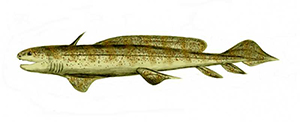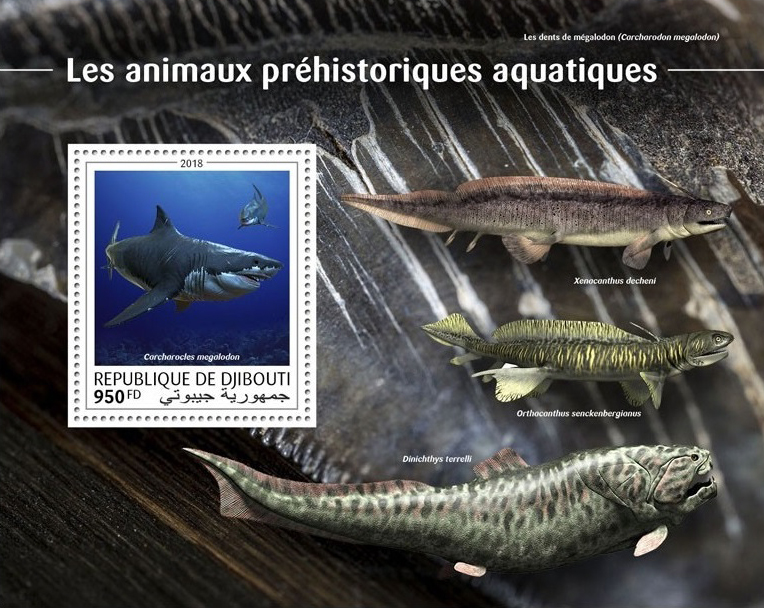Orthocanthus senckenbergianus Fritsch, 1889

(Da: it.wikipedia.org)
Phylum: Chordata Haeckel, 1874
Subphylum: Vertebrata Cuvier, 1812
Classe: Chondrichthyes Huxley, 1880
Ordine: Xenacanthida Glikman, 1964
Famiglia: Orthacanthidae Heyler and Poplin, 1989
Genere: Orthacanthus Agassiz, 1843
Specie e sottospecie
Il genere annovera attualmente le seguenti specie: Orthacanthus arcuatus (Newberry, 1856) - Orthacanthus cylindricus (Agassiz, 1843).
Descrizione
genere estinto di squali preistorici d'acqua dolce appartenenti all'ordine Xenacanthida. I membri del genere avevano una lunga colonna vertebrale che cresceva dal retro del cranio ed una pinna dorsale molto lunga, che percorreva tutta la lunghezza dell'animale facendolo assomigliare ad un'anguilla. Circa 260 milioni di anni fa gli Orthacanthus erano il terrore delle acque dolci di paludi e laghi in Europa ed in America del Nord. Il corpo raggiungeva i 3 metri di lunghezza e le potenti mascelle possedevano denti bicuspidi.
Diffusione
Sono apparsi circa 400 milioni di anni fa, nel Devoniano, e si sono estinti prima del Mesozoico, circa 225 milioni di anni fa.
Bibliografia
–Ivanov, Alexander (30 August 2005). "Early Permian chondrichthyans of the Middle and South Urals". Revista Brasileira de Paleontologia. 8 (2): 127-138.
–Luccisano, Vincent; Pradel, Alan; Amiot, Romain; Pouillon, Jean-Marc; Kindlimann, René; Steyer, Jean-Sébastien; Cuny, Gilles (2022). Cavin, Lionel (ed.). "Systematics, ontogeny and palaeobiogeography of the genus Orthacanthus (Diplodoselachidae, Xenacanthiformes) from the lower Permian of France". Papers in Palaeontology. 8 (6).
–Kriwet, J.; Witzmann, F.; Klug, S.; Heidtke, U. H. (2007). "First direct evidence of a vertebrate three-level trophic chain in the fossil record". Proceedings. Biological Sciences. 275 (1631): 181-186.
–Beck, Kimberly; Soler-Gijon, Rodrigo; Carlucci, Jesse; Willis, Raymond (2014). "Morphology and histology of dorsal spines of the xenacanthid shark Orthacanthus platypternus from the Lower Permian of Texas, USA: Palaeobiological and palaeoenvironmental implications" (PDF). Acta Palaeontologica Polonica.
–Soler-Gijón, R. (2004). "Development and growth in xenacanth sharks: new data from Upper Carboniferous of Bohemia". G. Arratia, M.V.H. Wilson, and R. Cloutier (Eds.), Recent Advances in the Origin and Early Radiation of Vertebrates: 533-562.
–Soler-Gijón, Rodrigo (December 2000). "Phylogenetic relationships of Lebachacanthidae [Soler-Gijón 1997] (Xenacanthiformes; Elasmobranchii)". PalZ. 74 (3): 363-377.
–Hotton, Nicholas (1952). "Jaws and Teeth of American Xenacanth Sharks". Journal of Paleontology. 26 (3): 489-500.
–Long, John A.; Young, Gavin C. (May 1995). "Sharks from the Middle-Late Devonian Aztec Siltstone, southern Victoria Land, Antarctica" (PDF). Records of the Western Australian Museum. 17: 287-308.

|
Data: 27/07/2018
Emissione: Animali marini preistorici Stato: Djibouti Nota: Presente nel foglietto |
|---|